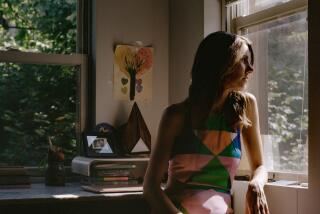Family photos, wrapping paper, icebergs — Leanne Shapton conjures ‘Ghost Stories’ from fragments
Leanne Shapton’s “Guestbook: Ghost Stories” reveals its intentions from the outside in. The main title is pressed into the book’s cover in black, while behind it, the subtitle hovers like a whisper, un-inked and virtually unseen. Call it a ghost trace, which is also how we might refer to each of the 33 stories here. Or more accurately, a kind of figure ground. Either way, it is a territory Shapton has been working for nearly 20 years.
My favorite work of hers, “Swimming Studies,” won the 2012 National Book Critics Award for autobiography. A memoir built of gestures, it was inspired by Shapton’s experience as a competitive swimmer; in its mix of text and images, the author, or her younger self, becomes a ghost of sorts, haunting (or inflecting) her own life. A related tension animates “Important Artifacts and Personal Property From the Collection of Lenore Doolan and Harold Morris, Including Books, Street Fashion and Jewelry,” a novel in the form of an auction catalog that marks the ebb and flow of a romance through the objects left in its wake.
It’s like catching a glimpse of the people who occupied your home before you did. Who are they? What happened to them?
— David L. Ulin
“Guestbook” works in similarly accretive fashion, juxtaposing images (some found, others made by Shapton) with short, epigrammatic texts. Although the book comes framed as a collection, it is really more a concordance of echoes, its narratives reflecting one another like mirrors showing their own faces back. “He told me twice about the visitation,” Shapton writes in “Patricia Lake,” one of the few pieces without graphics, “once soon after it happened and then again something like thirteen years later.”
This double vision, this back-and-forth between past and present, permeates “Guestbook.” In “Sirena de Gali,” photographs of women’s clothing — a longtime Shapton fascination — are underscored by prose fragments that offer glimpses of a life. In “Christmas Eve,” holiday wrapping paper art illustrates a micro-narrative about the inconsolability of longing, the way our secrets, and our secret losses, linger even after everything is gone.
“It occurred to her,” Shapton observes, describing a character at a holiday gathering, “that maybe the subject of ghosts was not cocktail party conversation. … There were other stories that were harder, impossible to tell. … Later, on the walk home, her friend elaborated: A suicide, an infanticide. Ghosts. Not ghost stories.”
That’s an essential distinction because with “Guestbook,” Shapton is after not so much a set of narratives as some sort of reckoning with the question of ghosts. It is inherent in the book’s construction, the detritus that become spectral presences throughout the work. The pictures, the art, the anecdotes and observations — all connect at the level of artifacts left behind. But even as she acknowledges this, Shapton strips everything of its original context so she can reanimate it, a ghost (herself) in the machine.
“A number of curious tragedies befell the Percy family,” she writes in “Georgehythe Place,” which unfolds primarily as a sequence of captions beneath what are presented as family photographs. “[T]his prompted local paranormal authorities to consider the family as possessing an unusual example of what is known as a ‘family ghost.’”
What Shapton is addressing is an existential condition, in which we are all ghosts in our own lives. We breathe, we die, we disappear, and what do we abandon? Nothing but a set of hints or suggestions that continue to shed their meaning the further they recede in time.
For Shapton, this is the whole idea, which means that in appropriating these images, their lost associations, she is seeking to reclaim and reframe them, tracing connections that might not otherwise emerge. It’s like catching a glimpse of the people who occupied your home before you did, who fought and loved and suffered and struggled, experienced grief and ecstasy. Who are they? What happened to them? I ask myself these questions all the time.
In some sense, that’s what “Guestbook” is also doing, exposing the ghosts of our common existence, the overlap between their lives and ours. Yes, these stories are constructed. (Stories are always constructed.) But they also offer bits of evidence. All those photographs: ghosts not just in time but also narrative. Their fate belongs to us, as well.
Late in the book, Shapton makes the point explicit, reminding us, “Remember what you don’t get to see.” This is in a piece called “Chrysanthemum, Carnation, Anemone, Foxglove,” and it’s no coincidence they are all perennials — a category of living ghost, if we want to think of them that way. “It is there in the dark,” Shapton insists. “It was there. It is still there.”
Nothing, in other words, is ever finished, even (or especially) after it is finished. We just need to learn to see.
::
Leanne Shapton
Riverhead: 304 pp, $30
Ulin is the author or editor of 10 books, including “Sidewalking: Coming to Terms With Los Angeles.” A 2015 Guggenheim Fellow, he is the former book editor and book critic of The Times.
More to Read
Sign up for our Book Club newsletter
Get the latest news, events and more from the Los Angeles Times Book Club, and help us get L.A. reading and talking.
You may occasionally receive promotional content from the Los Angeles Times.









